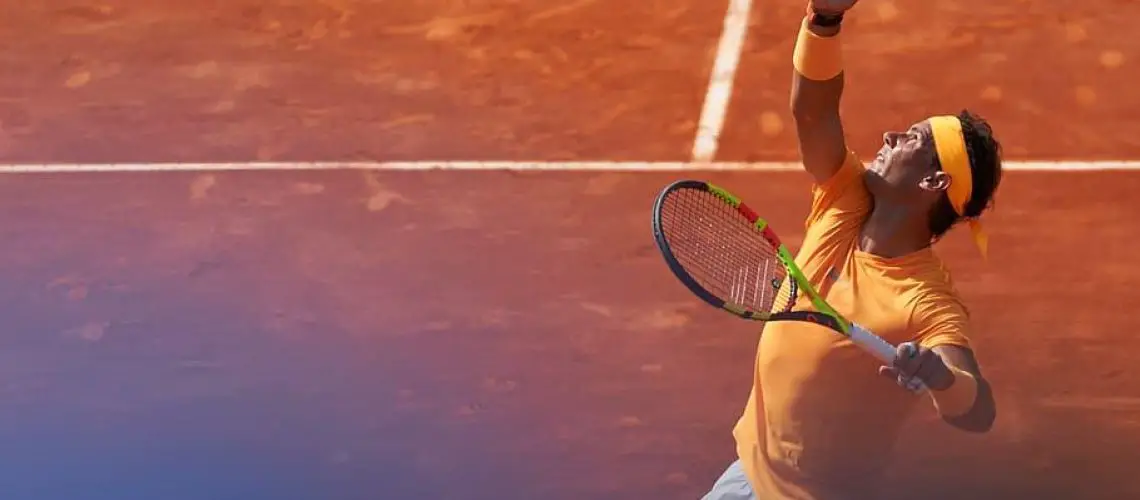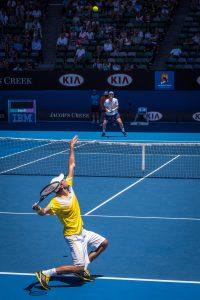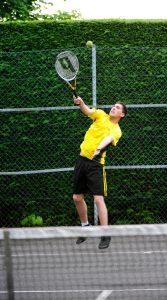We may earn money or products from the companies mentioned in this post.
A Quick Summary

Tiebreakers are an important part of modern tennis and understanding how they work is essential for players and fans. There are several formats for tiebreakers, and strategies such as mental strength, first-serve accuracy, attacking weak second serves, and minimizing errors are important for winning them. By following these strategies, players can increase their chances of winning tiebreakers and matches.
The Importance of Understanding Tennis Tiebreakers

Brief history of tennis tiebreakers
Tennis, as a sport, has been around for centuries and has undergone several rule changes over the years One such change was the introduction of tiebreakers in the 1970s Prior to this, matches that were tied at six games all in the final set would continue until one player had a two-game lead This often resulted in long and grueling matches that could last for hours or even days
The tiebreaker was introduced to speed up matches and provide an exciting conclusion to tight sets It is a system where players play points alternately until one player wins seven points with a two-point lead
Importance of tiebreakers in tennis matches
Tiebreakers have become an integral part of modern tennis and are used not only to decide sets but also to determine the outcome of entire matches, particularly in tournaments where there are strict time limits
They add an element of excitement and unpredictability to matches, allowing players who might be trailing earlier in the set to make comebacks and potentially win the match through a closely contested tiebreaker
Explanation of why understanding tiebreakers is essential for tennis enthusiasts
For avid tennis fans, understanding how tiebreakers work is crucial as it can greatly enhance their viewing experience Knowing when a tiebreaker may occur can build anticipation towards an exciting finale while following each point during a tense tiebreaker can help fans appreciate the skill and mental toughness required to succeed under pressure
Furthermore, knowledge about tiebreakers can also be useful for amateur players looking to improve their game by learning how to perform well under high-pressure situations
In conclusion, whether you’re a fan or player, understanding the importance of tiebreakers is essential in appreciating and enjoying the sport of tennis
| Key Point | Description |
|---|---|
| Anticipation | Knowing when a tiebreaker may occur builds anticipation towards an exciting finale |
| Appreciation | Following each point during a tense tiebreaker helps fans appreciate the skill and mental toughness required |
| Improvement | Knowledge about tiebreakers can help amateur players improve their game in high-pressure situations |
The Standard Tiebreaker: First to Seven Points

When a tiebreaker is initiated
The standard tiebreaker is a crucial part of many tennis tournaments and is initiated when the scores reach 6-6 in a set (except for the final set in some tournaments). It’s important to differentiate between sets and games, as games are scored differently In games, players must win by two clear points, while in sets, they must win six games first If the scores reach 5-5 in a set, players continue playing until one player wins seven games
Rules for winning the standard tiebreaker
To win the standard tiebreaker, players must reach seven points first with at least a two-point lead over their opponent Serving rotation during the tiebreaker follows specific rules; one serve for the initiating player followed by alternating sets of two serves per player Change of ends occurs after every six points played to ensure that neither player has an unfair advantage due to wind or other factors affecting one side of the court
Scoring system during a standard tiebreaker
The scoring system during a standard tiebreaker can seem complicated at first glance but follows straightforward rules The serving player’s score is always announced first, followed by their opponent’s score The first player to reach seven or more points with at least a two-point lead wins the game For example, if Player A has seven points while Player B has five points, Player A wins as they have achieved at least a two-point lead
In conclusion, understanding how and when to initiate a standard tiebreaker is essential knowledge for any tennis player or fan With its unique scoring system and serving rotation rules, it adds an exciting element of unpredictability to matches where players are evenly matched
| Key Point | Description |
|---|---|
| Initiate a standard tiebreaker | Essential knowledge for tennis players and fans |
| Unique scoring system | Adds excitement to matches with evenly matched players |
| Serving rotation rules | Ensures fair play during the tiebreaker |
The Final Set Tiebreakers: Formats and Variations

Traditional “Advantage Set” format
In the traditional “Advantage Set” format, there is no regular tiebreaker Instead, players must win by two games in the final set This means that if the score reaches 6-6 in the final set, play continues until one player has a two-game lead While this format can lead to some epic matches with dramatic finishes, it can also result in prolonged play and fatigue for both players
One of the pros of this format is that it allows for a true test of endurance and mental strength Players have to fight not only their opponents but also their own physical exhaustion and mental pressure Additionally, it can create more suspense and excitement for spectators as they watch players battle it out until the very end
However, one of the cons of this format is that it can be physically demanding on both players, potentially leading to injuries or fatigue that could impact future matches It can also make scheduling difficult for tournaments as matches could run longer than expected Despite these drawbacks, some tournaments still use this format, such as Wimbledon before 2019
Ten-Point Match Tiebreaker (Super Tiebreaker)
The Ten-Point Match Tiebreaker is used in place of a third or fifth set in some tournaments In this tiebreaker, the first player to reach ten points with at least a two-point lead over their opponent wins the set There are also rules regarding serving rotation and change of ends during this tiebreaker
This format has its advantages as it provides a quick resolution to matches without causing undue physical strain on players It also adds an element of excitement for spectators who witness high-stakes tiebreakers where every point counts
Twelve-Point Final Set Tiebreaker (used in Wimbledon since 2019)
The Twelve-Point Final Set Tiebreaker is a newer format that was introduced at Wimbledon in 2019 Once both players reach twelve games in the final set, this tiebreaker is used to determine the winner The rules for winning are identical to those of standard seven-point tiebreakers
This format has been well-received by players and spectators alike as it provides a fair and efficient way to conclude matches while avoiding prolonged play that could lead to injuries or exhaustion It also adds an exciting element of unpredictability as players fight for every point to secure their victory
Conclusion

Whether it’s the traditional “Advantage Set” format, Ten-Point Match Tiebreaker, or Twelve-Point Final Set Tiebreaker, each format has its pros and cons While some formats may be physically demanding on players and cause scheduling challenges for tournaments, others provide quick resolutions with added excitement for spectators Ultimately, the choice of which format to use depends on the specific tournament’s goals and priorities
| Format | Pros | Cons |
|---|---|---|
| Traditional “Advantage Set” | True test of endurance, more suspense and excitement | Physically demanding, scheduling challenges |
| Ten-Point Match Tiebreaker | Quick resolution, less physical strain, exciting for spectators | (not mentioned in the text) |
| Twelve-Point Final Set Tiebreaker | Fair and efficient, avoids prolonged play, exciting unpredictability | (not mentioned in the text) |
Advanced Tennis Tiebreaker Strategies

Importance of Mental Strength During Tiebreakers
Tiebreakers are known to be mentally challenging for tennis players In a tiebreaker, every point counts and there is no room for error Therefore, it is crucial to have mental strength during this phase of the game Players who are able to stay focused and composed during high-pressure situations tend to perform better in tiebreakers
One way to develop mental strength during tiebreakers is through visualization techniques Players can visualize themselves winning the tiebreaker and hitting successful shots under pressure This helps them build confidence and feel more prepared for the actual match scenario
Another important aspect of mental strength during tiebreakers is staying positive and maintaining a fighting spirit even if things don’t go as planned It’s essential not to dwell on past mistakes or missed opportunities but focus on each point at hand
Focusing on First-Serve Consistency and Accuracy
In a tiebreaker, every serve counts, so focusing on first-serve consistency and accuracy is vital A player’s first serve percentage can often be the determining factor in winning or losing a tight set
Players should aim to hit their first serves with pace and accuracy while mixing up the placement of their serves to keep their opponent off balance They should also avoid hitting second serves unless necessary since they give the opponent an opportunity to attack
Attacking the Opponent’s Second Serve
When playing against an opponent with a weak second serve, it’s vital to take advantage by attacking their second serve aggressively By doing so, players put pressure on their opponents and force them into making errors
To attack an opponent’s second serve successfully, players should look to step inside the baseline early while taking the ball on the rise or moving forward towards the net after hitting a return This puts the opponent under pressure and reduces their time to react
Utilizing High-Percentage Shots to Minimize Errors
In tiebreakers, it’s essential to minimize unforced errors while still being aggressive One way to achieve this is by utilizing high-percentage shots that have a higher chance of landing in the court
Players should focus on hitting deep, cross-court shots that keep their opponents on the run while minimizing the risk of making errors They should also look for opportunities to hit shots down-the-line or approach the net after hitting a solid groundstroke
Overall, these advanced tennis tiebreaker strategies can help players improve their performance in tight matches By developing mental strength, focusing on first-serve consistency and accuracy, attacking an opponent’s weak second serve and utilizing high-percentage shots, players can increase their chances of winning tiebreakers and ultimately, matches
| Strategy | Description |
|---|---|
| Develop mental strength | Stay focused and composed during high-pressure situations in tiebreakers |
| Focus on first-serve consistency | Aim for pace and accuracy while mixing up the placement of serves to keep the opponent guessing |
| Utilize high-percentage shots | Minimize unforced errors by hitting deep, cross-court shots and approaching the net when needed |
Useful Links

Tiebreaker Rules: In a tennis match, there are some major …
Guide to Tennis Tie Breaks
Rules For Playing a 10 Point Tie Break
What Are Tennis Tiebreakers and How Do They Work?
Tiebreaker & super tiebreaker rules – BookMaker
How to Play a Tiebreaker, History, and More
How does a tiebreaker in tennis work?
Tennis Tie-breaks Made Easy
What is a super tiebreak in tennis, rules, points and how is it …
How Do Tennis Tiebreaks Work?
What Is The Tennis Doubles Tie Breaker Rules?
Tiebreaker Rules and Scoring System at the 2023 …
Tennis | Rules and Equipment | Scoring basics: tie-break
How To Record A Tiebreak – Support – Universal Tennis
2022 US Open tiebreak rules: How does the final set … – Bolavip
Rules for Playing 10-Point Match Tiebreaker in Tennis
How Does a Tiebreaker Work in Tennis? History, Rules, & More
Tie-Break Serving Order. Meaning in tennis. Definition. …






